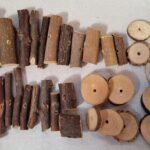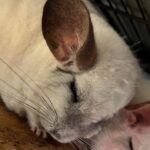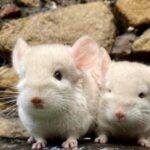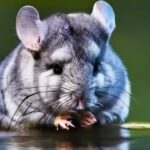Good quality hay is fine-stemmed, sweet smelling, clean and dry, bright with a nice light green-brown color. Bad hay smells, looks moldy, musty, looks dullish brown and dead. Avoid hay that is dusty, dirty and damp. Hay should be free of thorns and other rubbish. There are hay products processed by machine-dried or fast-dried method, which will look greener than usual. It should be dry though. This method improves hay’s nutritional content. There is a range of chinchilla hay and forage like alfalfa, timothy, orchard grass, mountain grass, alpine, brome, the blue grasses and the common grass are the most satisfactory for feeding chinchillas.

Pressed cubes of hay are chopped and compressed hay. They typically come in alfalfa or timothy. Both hay cubes and loose hay provide a chin with his necessary nutritional fibre. If you find and want to feed hay cubes, I suggest also feeding some loose hay as chinchillas seem to enjoy playing with it and also hay cube is difficult to be consumed by chins having dental problems. Another good for loose hay is that requires more grinding from the molars because it is not chopped like the compressed hay in hay cubes. Chinchilla hay cubes advantages is that are mess-free, they require far less space, chin cannot spread it all over the cage and they are very practical if you are traveling with your chin. Chinchilla hay cubes also have less dust than loose hay, making them less of an allergy irritant. Loose hay also helps to prevent cage-boredom to chinchillas, as they love to play with long stalks and stems, pulling them from their hayracks and throwing them around the cage, making quite a mess.
Chinchilla Pellets and Nutritional Requirements
Alfalfa hay or alfalfa chinchilla hay cubes should be given but they should not be fed exclusively. Too much alfalfa could lead to urinary and other problems, as it is high in protein, calcium, and oxalates. It is good for young chins and breeding chinchillas. Alfalfa should be fed as a treat only and not daily as a hay-replacement. Alfalfa should be introduced slowly to avoid squashy fecal droppings. Chinchillas that are sick, pregnant, underweight should be served alfalfa as primary hay.
What is Fibre?
Fibre is commonly described as indigestible parts of any feed. Fibre includes cellulose, hemicellulose, mucilage, pectin, gum, lignin, indigestible proteins and lipids. There are two types of fibre found in food and hay. Fibre is found primarily in plants in two main categories, non-digestible and digestible. Herbivores require a high percentage of non-digestible fibre. Even though his body does not digest it, healthy bacteria living in the digestive tract can. This breakdown produces volatile fatty acids, vitamins and other nutrients, which is a very good thing. Digestible fibre consists of plant carbohydrates that contribute significantly to the energy content in feed.
ADF (acid detergent fibre) and NDF (neutral detergent fibre).
Acid Detergent Fibre (ADF)
Measurement of the plant fibre that remains (cellulose and lignin) after an acidic detergent removes more digestible cell components. As ADF increases, the digestibility of hay decreases. ADF are the least digestible – and found in the stems and stalks. ADF is a laboratory estimate of the less digestible cellulose and lignin, or “woody” fibre, in the plant. ADF is the best indicator of the fibre requirement for healthy rumen fermentation. ADF is used to calculate many of the energy values that appear in hay analysis reports.
What Fruits Can Chinchillas Eat
Neutral Detergent Fibre (NDF)
This is the fibre that remains after using a neutral detergent to remove the cell contents and pectin. NDF value differs from ADF value in that it includes hemicellulose. NDF analysis is considered to be more useful for predicting intake as the higher the NDF, the lower the intake. NDF is more digestible – and found in the leaves of grasses. NDF is an estimate of the plant’s cell wall content. Some of this fibre is highly digestible. NDF is the best indicator of how much forage an animal will eat.
Small herbivores with imbalanced beneficial fiber-digesting bacteria in the digestive tract are prone to intestinal diseases and malnutrition. These bacteria need ADF to remain alive and healthy. In addition, ADF is insoluble in water and can increase fecal output, fecal size and food passage through the digestive tract. These aspects of ADF could help prevent intestinal blockages. A lack of ADF might result in gastrointestinal problems, including bloat, GI stasis and E. coli infection. Chinchillas do better (gut and tooth-wise) on a type of diet higher in ADF. Timothy hay contains a minimum of 32% fibre of which 25.10% is ADF. Other acceptable grass hays are orchard and bluegrass.
When storing loose chinchilla hay or hay cubes, store in a dry, cool and well-ventilated area. Store in containers with a good airflow. Hay has some inherent moisture and if kept in an airtight or tightly sealed container it can mold. Hay that have been exposed to dampness or have started fermenting must be disregarded, as deadly toxins will have starting developing in them. Always inspect the hay you provide to ensure no mould or fungi have begun to form.






